| Pages:
1
2 |
artemov
Hazard to Others
  
Posts: 181
Registered: 22-8-2018
Member Is Offline
|
|
Concentrating Battery Acid and Chromium Sulfate Synthesis
Managed to concentrate about 650ml of 37% (density ~1.28)battery acid to about 220ml of 81% (density ~1.75) in an open RBF. 3 diy PTFE chips are
used as boiling chips. Took about 5-6 hours, with the last half an hour characterised by a burning and choking (but not dense white) fumes which sent
me running.
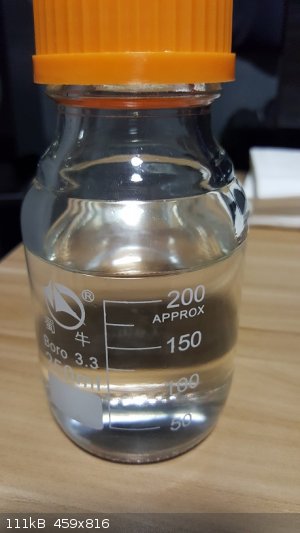 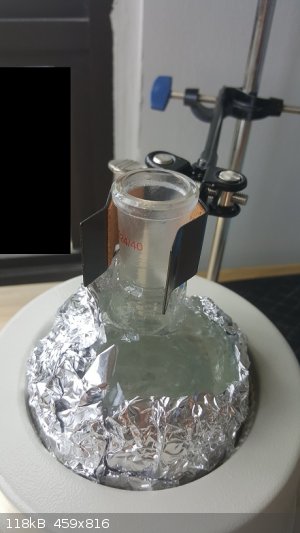
|
|
|
artemov
Hazard to Others
  
Posts: 181
Registered: 22-8-2018
Member Is Offline
|
|
On my quest towards potassium dichromate, I reacted 17.1g of chromium powder with 110ml of RT 36% battery acid to make chromium sulfate.
Despite my best effort to keep the temperature below 40 C using a cold water bath, the resultant solution is still dark green instead of violet. Does
it mean that I have the sulfato complex instead of the hexaaqua complex? Do I need to wait until it turns violet?
Also a pungent gas is emitted with hydrogen; not sure if it is hydrogen sulfide or sulfur dioxide. Is it possible?
Eventually I will add baking soda to precipitate chromium hydroxide if I am making potassium dichromate, but this batch will be used to grow chrome
alum crystals with potassium sulfate instead.
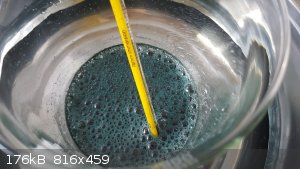 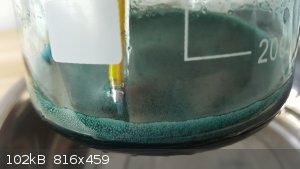
|
|
|
j_sum1
Administrator
       
Posts: 6320
Registered: 4-10-2014
Location: At home
Member Is Offline
Mood: Most of the ducks are in a row
|
|
Why were you expecting violet?
Cr(III) is typically deep green and Cr2(SO4)3 in solution certainly is.
Violet is Cr in +5 oxidation state which is difficult to isolate and incompatible with water.
Looks like you are doing just fine. Keep following your procedure.
(You probably did not need to boil down your acid. 37% would probably have done the trick just fine and you would have kept the temperature low more
easily.)
|
|
|
artemov
Hazard to Others
  
Posts: 181
Registered: 22-8-2018
Member Is Offline
|
|
Quote: Originally posted by j_sum1  | Why were you expecting violet?
Cr(III) is typically deep green and Cr2(SO4)3 in solution certainly is.
Violet is Cr in +5 oxidation state which is difficult to isolate and incompatible with water.
Looks like you are doing just fine. Keep following your procedure.
(You probably did not need to boil down your acid. 37% would probably have done the trick just fine and you would have kept the temperature low more
easily.) |
Thanks j_sum1, I understand that the green form is some kind of sulfate complex (due to high temp?), for example, from https://woelen.homescience.net/science/chem/exps/crIII/index...
I used 36-37% battery acid to make my chromium sulfate, not my boiled down 81% sulfuric acid.
[Edited on 4-1-2020 by artemov]
|
|
|
Tsjerk
International Hazard
    
Posts: 3032
Registered: 20-4-2005
Location: Netherlands
Member Is Offline
Mood: Mood
|
|
From Woelen's site:
| Quote: | | When a solution of chromium(III)sulfate or chrome alum is boiled down, then finally one ends up with a green syrup. When this is allowed to cool down,
then a glassy green substance is obtained, which is very hard to crystallize. The reason for this is that the substance is not a well-defined entity
with a clear structure, but it is a complicated mix of different sulfato-complexes with varying amount of water, depending on how much it was
evaporated. |
I guess having the chromium(III) in a concentrated and highly acid environment also yields a green syrup. Nothing to worry about, just continue with
what you were planning to do.
What are you planning to do?
|
|
|
artemov
Hazard to Others
  
Posts: 181
Registered: 22-8-2018
Member Is Offline
|
|
Quote: Originally posted by Tsjerk  |
I guess having the chromium(III) in a concentrated and highly acid environment also yields a green syrup. Nothing to worry about, just continue with
what you were planning to do.
What are you planning to do? |
Also from the "Chromium Revisited" document found on SM:
| Quote: |
(3) Aqua Complexes:
(3a) Heat a small amount of the violet (purple by transmitted light) solution of Cr[III] sulphate to boiling for a few minutes. The solution turns
from violet to deep green. On cooling it preserves the green color. It will stay green for several days to weeks but finally return to
the original violet. The green form is chemically differentfrom the violet form as can be shown by precipitation of the sulphate
ion with a barium salt, and also by electric conductivity or freezing point measurement.The green salt does not form a
precipitate.The mystery was solved in the early 1900s; the violet ion is the complex Cr(H2O)6+++; the dark green one maybe
[Cr(H2O)4(SO4)]+; or perhaps [Cr2(H2O)l0(SO4)]++++ or the covalent [Cr2(H2O)6(SO4)3], or a mixture of all three.
Only the violet form will crystallize. If the green form is heated to dryness, only green scales result. Further
cautious heating produces an orange-yellow product which is the anhydrous form with perhaps some decomposition. Strong heating (bright red heat)
causes decomposition and SO3 evolution: Cr2(SO4)3 -> Cr2O3 + 3SO3
For the chloride of Cr[iii], Wiki has:“Chromium(III) chloride(also called chromic chloride) is a violet coloured solid with the formula CrCl3. The
most common form of CrCl3 sold commercially is a dark green hexahydrate with the formula [CrCl2(H2O)4]Cl.2H2O. Two other hydrates
are known, pale green [CrCl(H2O)5]Cl2.H2O and violet [Cr(H2O)6]Cl3. This unusual feature of chromium(III) chlorides, having a series of
[CrCl3−n(H2O)n]z+, each of which is isolable, is also found with other chromium(III) compounds.”
This indicates the facility with which Cr forms complexes, in this case with water. It is also interesting to note that both Cr[III] sulphate and
chloride, if anhydrous, are virtually insoluble in water. The crystalline form of sulphate is Cr2(SO4)3.12H2O or, according to the above,
[Cr(H2O)6]2(SO4)3.6H2O, and is very soluble
|
For this batch I intend to grow chrome alum crystal, so I am worried the green form will not crystallize properly.
The next batch will be used to make chromium hydroxide, which I think will be ppted by sodium bicarbonate from both the green and violet form ... not
100% sure though.
|
|
|
unionised
International Hazard
    
Posts: 5126
Registered: 1-11-2003
Location: UK
Member Is Offline
Mood: No Mood
|
|
Chrome alum crystals are practically black unless they are very small.
You can co-crystallise it with ordinary alum and get a range from deep to pale violet.
The hydrolysis of the green sulphate complex is slow.
It's likely that, if you add bicarbonate you will get a basic sulphate rather than pure "Cr(OH)3"
|
|
|
Tsjerk
International Hazard
    
Posts: 3032
Registered: 20-4-2005
Location: Netherlands
Member Is Offline
Mood: Mood
|
|
Quote: Originally posted by artemov  |
The next batch will be used to make chromium hydroxide, which I think will be ppted by sodium bicarbonate from both the green and violet form ... not
100% sure though. |
What is the step after that? Considering what unionised said, that is probably relevant in this case.
|
|
|
S.C. Wack
bibliomaster
    
Posts: 2419
Registered: 7-5-2004
Location: Cornworld, Central USA
Member Is Offline
Mood: Enhanced
|
|
Quote: Originally posted by artemov  | Do I need to wait until it turns violet?
Also a pungent gas is emitted with hydrogen; not sure if it is hydrogen sulfide or sulfur dioxide. Is it possible? |
If there is excess acid I'm not sure if that will speed that up or slow it down. SO2 is likely. The normal preparation of the double salt from
dichromate calls for boiling, so that's the green form. That ends with either a seed crystal or a week of waiting for the conversion. It is said that
the waiting produces better crystals.
|
|
|
artemov
Hazard to Others
  
Posts: 181
Registered: 22-8-2018
Member Is Offline
|
|
Thanks guys.
I am currently filtering the "green syrup". There seems to be some sedimentation despite having used a slight excess of sulfuric acid.
Unionised
| Quote: | | It's likely that, if you add bicarbonate you will get a basic sulphate rather than pure "Cr(OH)3" |
I have read somewhere that both the green and violet form will yield chromium hydroxide ... fingers crossed. Do you have any reference on the basic
sulfate?
Tsjerk
| Quote: | | What is the step after that? |
The chromium hydroxide ppt will be washed several times, dissolved will NaOH, then oxidised by bleach+more NaOH to chromate. This is according to the
"Chromium Revisited" document.
S. C. Wack
| Quote: | | If there is excess acid I'm not sure if that will speed that up or slow it down. SO2 is likely. The normal preparation of the double salt from
dichromate calls for boiling, so that's the green form. That ends with either a seed crystal or a week of waiting for the conversion. It is said that
the waiting produces better crystals. |
Yes, most synthesis of chrome alum from potassium dichromate involved high temp or boiling, which is puzzling. Maybe, hopefully, it doesn't matter if
it's green or violet 
This guy seems to have the green/violet conundrum too ...
http://www.sciencemadness.org/talk/viewthread.php?tid=78750
The reply from woelen in that thread
| Quote: | Your problem indeed is that the temperature was too high. Chromium(III) ions form dark purple/grey hexaaqua ions, which crystallize with sulfate ions
and potassium ions to give chrome alum. If the liquid is too hot, then you get a sulfato-complex of chromium, which has a deep green color. This
sulfato-complex is very stable and it will take weeks or even months on cold storage before it is converted back to hexaaqua chromium(III) ions and
free sulfate ions.
The green sulfato-complex does not crystallize well. If you heat the liquid, you get a thick green fairly acidic syrup, which on standing will form a
hard glassy mass or a sticky paste (depending on how much excess H2SO4 there is). Both are undesirable products.
Your only remedy now is to allow this green liquid to stand for a few weeks. Eventually it will convert back to free sulfate ions and chromium(III)
ions.
it is good to have a little excess acid in the reaction mix. You definitely should not have a too high pH, because that will lead to formation of a
fine precipitate, which makes formation of nice crystals nearly impossible. |
|
|
|
artemov
Hazard to Others
  
Posts: 181
Registered: 22-8-2018
Member Is Offline
|
|
Quote: Originally posted by artemov  | Thanks guys.
I am currently filtering the "green syrup". There seems to be some sedimentation despite having used a slight excess of sulfuric acid.
|
The green syrup took the entire day to filter  ... ...
There seems to be quite a fair bit of shiny metallic powder left behind. Addition of 37% sulfuric acid yields no reaction. This means my 99A chromium
powder from China is not that pure afterall. But what could these be?
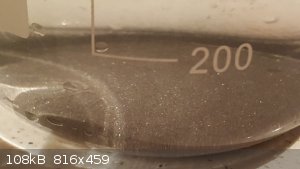
|
|
|
S.C. Wack
bibliomaster
    
Posts: 2419
Registered: 7-5-2004
Location: Cornworld, Central USA
Member Is Offline
Mood: Enhanced
|
|
Perhaps the sulfurous smell and resistant metal are closely related; i.e. you have passivated your Cr.
|
|
|
Tsjerk
International Hazard
    
Posts: 3032
Registered: 20-4-2005
Location: Netherlands
Member Is Offline
Mood: Mood
|
|
Your metal is probably pure but passivated as S.C. Wack said. Maybe a little hydrogen peroxide would help?
If your next step is dissolving in NaOH and oxidation with bleach, it shouldn't really matter whether your product is purple or green. The NaOH will
take care of that. Is it crystallized already? If not you can boil it down until it does.
|
|
|
artemov
Hazard to Others
  
Posts: 181
Registered: 22-8-2018
Member Is Offline
|
|
Oh dear,what happened? 
Tsjerk, not yet, I am still waiting for it to turn violet.
|
|
|
woelen
Super Administrator
        
Posts: 8012
Registered: 20-8-2005
Location: Netherlands
Member Is Offline
Mood: interested
|
|
Chromium is a very peculiar element, in terms of how it behaves in its coordination chemistry.
If chromium(III) is formed from another oxidation state (e.g. from the metal by means of oxidation, or from hexavalent chromium by means of
reduction), then it almost certainly coordnates to some ion, present in the solution. In your case, the chromium(III), formed in the reaction in which
the metal is oxidized, is coordinated to sulfate ions, giving a green solution. This green complex slowly will decompose to free sulfate ions and the
chromium will become coordinated to water. This reaction takes a few weeks.
Chromium(III) also coordinates to sulfate ion on heating. If you have a solution of chrome alum or chromium sulfate, then it is purple/blue/grey (a
little bit hard to describe color). On heating, the solution turns green. It then takes days or even weeks before that green solution turns purplish
again.
Making coordination complexes of chromium indeed frequently is done by first bringing the element in another oxidation state than +3 (either one
starts from dichromate and this is reduced, or chromium(III) is reduced with zinc powder to chromium(II) and then reoxidized in the presence of the
ion which must be coordinated to the metal).
If you want to make chrome alum from your solution, then you also need to dissolve some potassium salt (best is K2CO3). For the rest, you need
patience. The green material slowly will convert to the purple aquated ion.
So, dissolving Cr-metal in H2SO4 is not the best way to start with.
What you could do is precipitate the chromium with KOH (or more conveniently K2CO3), so that you get Cr(OH)3 (contaminated with a lot of potassium
ions and sulfate ions, but that is no issue at all in your case). Next, you can dissolve the precipitate (while still fresh) in ice-cold dilute H2SO4
and also dissolve some K2CO3 in order to get K(+) ions as well in solution. Keep the solution slightly acidic. Next, allow to evaporate slowly. This
will produce crystals of chrome alum.
|
|
|
artemov
Hazard to Others
  
Posts: 181
Registered: 22-8-2018
Member Is Offline
|
|
Quote: Originally posted by woelen  | .
For the rest, you need patience. The green material slowly will convert to the purple aquated ion.
What you could do is precipitate the chromium with KOH (or more conveniently K2CO3), so that you get Cr(OH)3 (contaminated with a lot of potassium
ions and sulfate ions, but that is no issue at all in your case). Next, you can dissolve the precipitate (while still fresh) in ice-cold dilute H2SO4
and also dissolve some K2CO3 in order to get K(+) ions as well in solution. Keep the solution slightly acidic. Next, allow to evaporate slowly. This
will produce crystals of chrome alum. |
Thanks woelen. 2 queries if you dun mind.
Does Na or K bicarbonate precipitate Cr(OH)3 from the green form of Cr2(SO4)3 as well?
To make chrome alum, do the Cr and K ions have to have the same molar concentration exactly? I will be adding potassium sulfate to my chromium sulfate
solution.
|
|
|
woelen
Super Administrator
        
Posts: 8012
Registered: 20-8-2005
Location: Netherlands
Member Is Offline
Mood: interested
|
|
The bicarbonate also precipitates chromium, but I think that you then get basic carbonate and carbon dioxide. That does not need to be a problem for
you if you redissolve the materials again in acid.
The molar ratio of K(+) and Cr(3+) does not need to be exactly 1 : 1. Of course, it is better to have a ratio, close to this, but you need not be
meticulously accurate with this. Try to avoid a lot of excess acid, but having a slightly acidic solution is fine. It prevents hydrolysis of
chromium(III) and formation of basic sulfates.
@j_sum1: Chromium in oxidation state +3 and Cr2(SO4)3.xH2O do not need to be green. The common color of chromium(III) is purplish/blue/grey, the color
of the hexaqua-complex [Cr(H2O)6](3+). With many anions, however, complexes are formed, of which many indeed are green. The sulfato complex is dark
green with a slightly bluish hue (the above pictures render the color quite well on my screen), the chloro complex is purely green. Common hydrated
chromium(III) sulfate is dark purple (looks very much like chrome alum, but forms less clearly distinguished crystals), but you can also get dark
green chromium sulfate. I have both forms. The green form is less common, but you can buy it from chemcraft.su, a seller who sometimes posts something
on sciencemadness.
Chromium in oxidation state +5 is not purple. The only +5 oxidation state compound I know of chromium is in the CrO8(3-) ion, which in fact is a
peroxo complex, which better can be written as [Cr(O2)4](3-). I made K3CrO8 a several years ago. This is easy to make and isolate in the pure state.
If you want to make chrome alum, then you definitely must have the chromium in solution as the hexaqua ion, otherwise no crystals are formed, and you
get a thick green syrup, which solidifies to an amorphous and somewhat sticky mass.
|
|
|
j_sum1
Administrator
       
Posts: 6320
Registered: 4-10-2014
Location: At home
Member Is Offline
Mood: Most of the ducks are in a row
|
|
Quote: Originally posted by j_sum1  | Why were you expecting violet?
Cr(III) is typically deep green and Cr2(SO4)3 in solution certainly is.
Violet is Cr in +5 oxidation state which is difficult to isolate and incompatible with water. |
Quote: Originally posted by woelen  |
@j_sum1: Chromium in oxidation state +3 and Cr2(SO4)3.xH2O do not need to be green. The common color of chromium(III) is purplish/blue/grey, the color
of the hexaqua-complex [Cr(H2O)6](3+). With many anions, however, complexes are formed, of which many indeed are green. The sulfato complex is dark
green with a slightly bluish hue (the above pictures render the color quite well on my screen), the chloro complex is purely green. Common hydrated
chromium(III) sulfate is dark purple (looks very much like chrome alum, but forms less clearly distinguished crystals), but you can also get dark
green chromium sulfate. I have both forms. The green form is less common, but you can buy it from chemcraft.su, a seller who sometimes posts something
on sciencemadness.
Chromium in oxidation state +5 is not purple. The only +5 oxidation state compound I know of chromium is in the CrO8(3-) ion, which in fact is a
peroxo complex, which better can be written as [Cr(O2)4](3-). I made K3CrO8 a several years ago. This is easy to make and isolate in the pure state.
|
One of the things I love about this place is that I can spout crap and everyone is gracious and continues a productive conversation.
Another thing I love is when woelen comes along and sets the record straight with his extensive knowledge and experience.
I was referring to a half-baked memory of chromium oxide peroxide (CrO5), which I inadvertently made once. It is deep blue/purple and very transient
in aqueous solution. It lasted maybe a second before disappearing, It can apparently be extracted using diethyl ether and looks rather pretty.
Now that I think about it, I have come across purplish chrome-alums. But all of my experience with Cr2(SO4)3 has been deep forest green.
My apologies for the confusion and needless diversion.
|
|
|
S.C. Wack
bibliomaster
    
Posts: 2419
Registered: 7-5-2004
Location: Cornworld, Central USA
Member Is Offline
Mood: Enhanced
|
|
I note that Brauer's entry for the chromous salt has 20 g. Cr dissolving completely in 150 ml water + 46 g. conc. sulfuric, though he does not say how
long this takes and perhaps his reference doesn't mention this either...he doesn't mention exclusion of air either but I'd think this would be a
requirement. Presumably there is some ideal concentration/temperature for dissolving Cr with or without oxygen but it's not easily found.
|
|
|
chornedsnorkack
National Hazard
   
Posts: 563
Registered: 16-2-2012
Member Is Offline
Mood: No Mood
|
|
Was chromium oxidized to Cr(III) by oxygen or by proton? When dissolving metal Cr in a non-oxidizing acid, do you get Cr(II) first?
|
|
|
woelen
Super Administrator
        
Posts: 8012
Registered: 20-8-2005
Location: Netherlands
Member Is Offline
Mood: interested
|
|
I have the impression that dissolving chromium in a non-oxidizing acid (e.g. HCl or dilute H2SO4) results in formation of hydrogen and a mix of Cr(2+)
and Cr(3+). I never was able to make a purely sky blue solution of Cr(2+) by dissolving chromium metal. Cr(2+) is strongly reducing and most likely in
acidic solution it reduces water (or H(+) ions) with formation of hydrogen. The only way in which I could get a nice blue solution of Cr(2+) was with
finely powdered zinc metal, but when the zinc was used up, the liquid fairly quickly turned green again.
|
|
|
Fery
International Hazard
    
Posts: 1015
Registered: 27-8-2019
Location: Czechoslovakia
Member Is Offline
|
|
Quote: Originally posted by woelen  | | The only way in which I could get a nice blue solution of Cr(2+) was with finely powdered zinc metal, but when the zinc was used up, the liquid fairly
quickly turned green again. |
was it still in oxygen free environment after all Zn was used up?
I remember prepartion of Cr(II) acetate which started in a flask with air but O2 was consumed soon and expelled with H2 too, the reaction flask with
CrCl3(aq)+HCl(aq)+Zn(s) had a stopper with 2 outlet tubes with hoses: tube 1 with hose opened and tube 2 submersed to the bottom of the flask and with
hose closed, at the end of reaction when the color finally changed from green to blue the hose of tube 2 was opened and tube 1 closed so H2 pressure
slowly caused the content of flask to exit through the tube 2 into solution of NaAc where red Cr2(II) acetate precipitated
|
|
|
S.C. Wack
bibliomaster
    
Posts: 2419
Registered: 7-5-2004
Location: Cornworld, Central USA
Member Is Offline
Mood: Enhanced
|
|
Inorg. Syn. 10, 26 has directions (in short, avoid oxygen...phrases such as "rigorously free" are used) for chromous sulfate, perchlorate, and halides
(quantitative yields) by dissolving in the acids; the recommended concentration of sulfuric acid is 20%. So, higher concentrations may be unwise.
If baking soda (or the carbonate it's easily converted to) precipitates more or less the hydroxide from Cr+3, it may still be contaminated with
sodium. Ammonia can be used as the base if it's not the usual sudsy grocery store ammonia.
|
|
|
artemov
Hazard to Others
  
Posts: 181
Registered: 22-8-2018
Member Is Offline
|
|
Chrome alum:
Since I have completely messed up the stoichiometry, I added what seems to me to be an appropriate amount of potassium sulphate (aq) to my chromium
sulphate solution. Now evaporating in a shallow container covered with a kitchen towel.
Chromium hydroxide:
Sodium bicarbonate (aq), converted from baking soda, is adding to the chromium sulphate solution. Added too fast, resulting in excessive foaming and
overflow. Lost about 1/3 of the product. Again stoichiometry is messed up 
Waiting for the fluffy green chromium hydroxide to settle. Taking way too long. Supernate is nearly colorless and clear with a neutral pH.
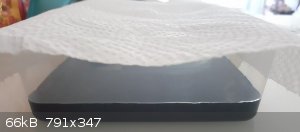
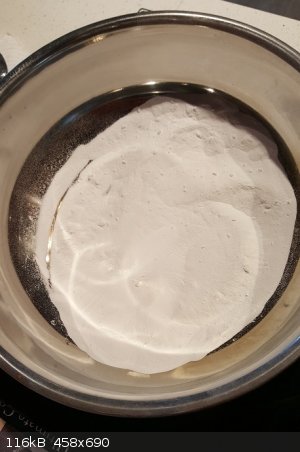 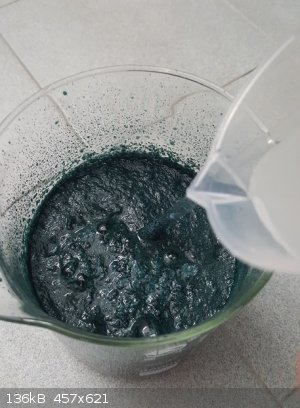 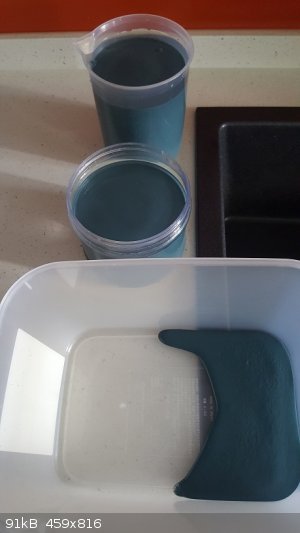
|
|
|
artemov
Hazard to Others
  
Posts: 181
Registered: 22-8-2018
Member Is Offline
|
|
Hi guys, I need to clean up my labware later after a dichromate synthesis.
I have sodium metabisulfite. Do I just use water, or do I need to add some acid to reduce the pH first for the reduction of Cr6+ to Cr3+ to work?
Cheers.
|
|
|
| Pages:
1
2 |